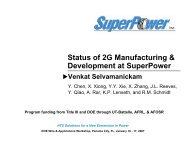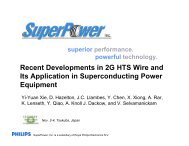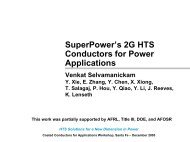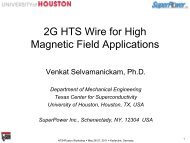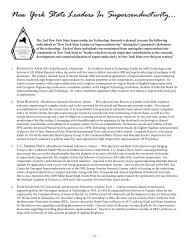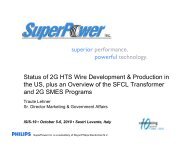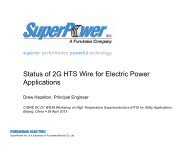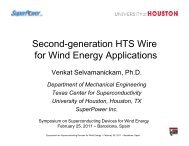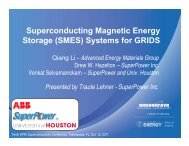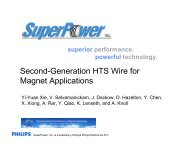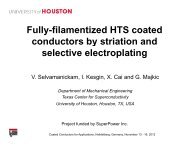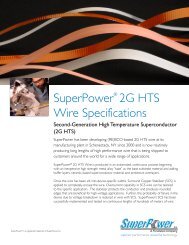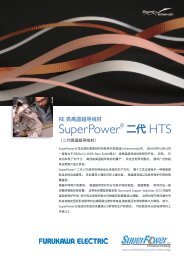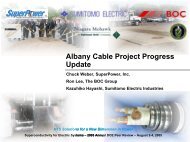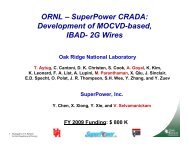Non-Vacuum Deposition of Buffer Layers and SuperPower CRADA ...
Non-Vacuum Deposition of Buffer Layers and SuperPower CRADA ...
Non-Vacuum Deposition of Buffer Layers and SuperPower CRADA ...
You also want an ePaper? Increase the reach of your titles
YUMPU automatically turns print PDFs into web optimized ePapers that Google loves.
<strong>Non</strong>-<strong>Vacuum</strong> <strong>Deposition</strong> <strong>of</strong> <strong>Buffer</strong> <strong>Layers</strong> <strong>and</strong><br />
<strong>SuperPower</strong> <strong>CRADA</strong>: Budget: 400 K<br />
Presenter: Raghu N. Bhattacharya (NREL) <strong>and</strong><br />
Maxim Martchevskii (<strong>SuperPower</strong> Inc.)<br />
Co-Authors: Wenjun Zhao (NREL), Jonathan<br />
Mann (NREL), Yi-Yuan Xie <strong>and</strong> Venkat<br />
Selvamanickam (<strong>SuperPower</strong> Inc.)<br />
Acknowledgements: Andrew Norman, Bobby<br />
To, Sovannary Phok, Anna Duda, Phil Parilla,<br />
Glenn Teeter <strong>and</strong> Lynn Gedvilas (NREL)<br />
Venue: Alex<strong>and</strong>ria, VA; Date: August 4-6, 2009<br />
This work has been performed by an employee <strong>of</strong> the Alliance for Sustainable Energy, LLC under contract number DE-AC-36-08GO-28308 with the US. department <strong>of</strong> Energy.<br />
The United States Government retains a non-exclusive, paid-up, irrevocable, worldwide license to publish or reproduce the published form <strong>of</strong> this work, or allow others to do so,<br />
for United States Government purposes.<br />
NREL is a national laboratory <strong>of</strong> the U.S. Department <strong>of</strong> Energy Office <strong>of</strong> Energy Efficiency <strong>and</strong> Renewable Energy operated by the Alliance for Sustainable Energy, LLC
NREL AND SUPERPOWER INC. <strong>CRADA</strong><br />
• We transferred the electrodeposited Custabilizer<br />
technology to <strong>SuperPower</strong> Inc.<br />
• We are developing electroplated Agstabilization<br />
layer directly on a YBCO<br />
superconductor.<br />
National Renewable Energy Laboratory<br />
Innovation for Our Energy Future
Electrodeposition Process<br />
Electrical variables: • Potentials (V) (half-cell potential, overpotential, …)<br />
• Current (I)<br />
• Coulombs (Q)<br />
Cu 2+ +2e – Cu<br />
Ag 1+ + e - Ag<br />
Electrical variables:<br />
• Mode (diffusion, convection)<br />
• Surface concentration<br />
• Adsorption<br />
Electrode variables:<br />
• Material<br />
• Surface area<br />
• Geometry<br />
• Surface condition<br />
Solution variables:<br />
• Bulk concentration <strong>of</strong> electroactive [C O , C R ]<br />
• Concentrations <strong>of</strong> other species (electrolyte, pH, …)<br />
• Solvent<br />
National Renewable Energy Laboratory<br />
Innovation for Our Energy Future
Electrodeposition<br />
Mass Transfer to an electrode is governed by the Nernst-Planck Equation:<br />
J i (x) = – D i δC(x)/ δx [diffusion] – (z i F/RT)D i C i δФ(x)/ δx [migration]<br />
+ C i v(x) [convection]<br />
Where<br />
J i (x) = Flux <strong>of</strong> the species i (mol sec -1 cm -2 ) at distance x from the surface<br />
D i = Diffusion coefficient (cm 2 /sec)<br />
δC(x)/ δx = Concentration gradient at distance x<br />
δФ(x)/ δx = Potential gradient<br />
z i = Charge; C i = Concentration <strong>of</strong> species i<br />
v(x) = The velocity (cm/sec) with which a volume element in solution moves along<br />
the axis<br />
F = Faraday constant (9.64846 x 10 4 C/equiv)<br />
R = Molar gas constant (8.31441 J mol -1 -K -1 )<br />
The minus sign arises because the direction <strong>of</strong> the flux opposes the direction <strong>of</strong><br />
increasing electrochemical potential<br />
National Renewable Energy Laboratory<br />
Innovation for Our Energy Future
Electrodeposition<br />
The diffusion-limited plating current, i d<br />
, for a single species is<br />
given by following Cottrell equation:<br />
i (t) = i d (t) = nFAD 0<br />
1/2<br />
C 0* / 1/2 t 1/2<br />
The limiting current, i l<br />
, when the largest rate <strong>of</strong> mass transfer<br />
occurs under stirring condition is given by the following equation:<br />
i l = nFAm 0 C 0<br />
*<br />
Both equations show that current density is directly proportional to<br />
the concentration <strong>of</strong> solution that can be optimized to obtain the<br />
desired amount <strong>of</strong> deposited material on the electrode surface.<br />
n = number <strong>of</strong> electrons involved in the reaction; F= Faraday<br />
constant; A = area; D o<br />
= diffusion coefficient, C o*<br />
= concentration <strong>of</strong><br />
O in the bulk solution (far from the electrode), t = time; m 0<br />
= mass<br />
transfer coefficient.<br />
National Renewable Energy Laboratory<br />
Innovation for Our Energy Future
The Electrodeposition <strong>of</strong> Cu <strong>and</strong> Ag Films<br />
Cu 2+ + 2e - <br />
Cu (s)<br />
E = E 0 Cu + RT/2F ln [Cu2+ ] = 0.337 + 0.0295 log [Cu 2+ ] (vs. SHE)<br />
Cu 1+ + e - Cu (s)<br />
E = E 0 Cu + RT/F ln [Cu1+ ] = 0.520 + 0.0591 log [Cu + ] (vs. SHE)<br />
Ag 1+ + e - Ag (s)<br />
E = E 0 Ag + RT/F ln [Ag+ ] = 0.799 + 0.0591 log [Ag + ] (vs. SHE)<br />
National Renewable Energy Laboratory<br />
Innovation for Our Energy Future
Cyclic Voltammogram <strong>of</strong> Copper Solution<br />
Cu + + e - Cu<br />
National Renewable Energy Laboratory<br />
Innovation for Our Energy Future
Cyclic Voltammogram <strong>of</strong> Silver Solution<br />
Ag + + e - Ag<br />
Ag + + e - Ag<br />
National Renewable Energy Laboratory<br />
Innovation for Our Energy Future
SEM <strong>of</strong> Electrodeposited Ag<br />
ED-Ag from Perchlorate solution<br />
ED-Ag<br />
Glass/Mo<br />
ED-Ag<br />
Glass/Mo<br />
ED-Ag from AgNO 3 /Acetonitrile<br />
National Renewable Energy Laboratory<br />
Innovation for Our Energy Future
ED-Ag/YBCO from NH 4 OH <strong>and</strong> Water Based Solution<br />
ED-Ag<br />
<strong>SuperPower</strong> YBCO<br />
TEM shows the<br />
structure <strong>of</strong> ED-<br />
Ag/YBCO/<strong>Buffer</strong><br />
<strong>Layers</strong>/NiW.<br />
The interface <strong>of</strong><br />
Ag/YBCO is sharp.<br />
No interfacial reaction<br />
was observed.<br />
0.5m<br />
Substrate<br />
National Renewable Energy Laboratory<br />
Innovation for Our Energy Future
ED-Ag/YBCO from NH 4 OH <strong>and</strong> Water Based Solution<br />
3.5m Ag<br />
TEM shows a 3.5 µm<br />
ED-Ag layer on YBCO<br />
<strong>SuperPower</strong> YBCO<br />
National Renewable Energy Laboratory<br />
Innovation for Our Energy Future
ED-Ag/YBCO from NH 4 OH <strong>and</strong> Water Based Solution<br />
Ag<br />
8 0 0<br />
6 0 0<br />
Ag A g<br />
A g<br />
A g<br />
Ac q u ir e E D X<br />
A g<br />
4 0 0<br />
A g<br />
2 0 0<br />
C u<br />
C u<br />
O C u<br />
A g<br />
A g<br />
A g<br />
C u<br />
C u<br />
<strong>SuperPower</strong> YBCO<br />
2 0 0<br />
5<br />
1 0<br />
E n e r g y ( k e V )<br />
C u<br />
Cu<br />
1 5<br />
1 5 0<br />
C u<br />
C u<br />
C u<br />
Ba<br />
B a<br />
B a<br />
1 0 0<br />
O<br />
Y<br />
B a<br />
B a<br />
Y<br />
TEM <strong>and</strong> EDS analysis show<br />
there is no interfacial reaction<br />
between Ag <strong>and</strong> YBCO.<br />
E<br />
5 0<br />
Y<br />
Y<br />
A g<br />
AgA g<br />
A g A g<br />
A g<br />
B a<br />
A g<br />
A g A g<br />
B a<br />
5<br />
B a<br />
B a<br />
C u<br />
1 0<br />
n e rg y (k e V )<br />
Y<br />
1 5<br />
National Renewable Energy Laboratory<br />
Innovation for Our Energy Future
ED-Ag/YBCO from Acetonitrile Solution<br />
3m ED-Ag<br />
Clean Interface<br />
<strong>SuperPower</strong> YBCO<br />
Substrate<br />
National Renewable Energy Laboratory<br />
Innovation for Our Energy Future
ED-Ag/YBCO from Acetonitrile Solution<br />
600<br />
Ag<br />
Ar<br />
Ag<br />
Ag<br />
Ar<br />
Acquire EDX<br />
ED-Ag<br />
Counts<br />
400<br />
Ag<br />
200<br />
O<br />
S<br />
SAg<br />
Ag Ba<br />
Ba<br />
Ba<br />
Ba<br />
Ba Ba<br />
Ag<br />
Ba<br />
Ba<br />
Ni<br />
Cu<br />
Ni<br />
Cu<br />
5<br />
10<br />
Energy (keV)<br />
15<br />
20<br />
250<br />
Cu<br />
Acquire EDX<br />
200<br />
Ni<br />
Cu<br />
Ba<br />
Ba<br />
Ba<br />
<strong>SuperPower</strong> YBCO<br />
Counts<br />
150<br />
100<br />
50<br />
Cu<br />
Cu<br />
Ni<br />
Y<br />
Y<br />
Y<br />
Ag<br />
Ag<br />
Y Ag Ba<br />
Ag Ag<br />
Ag<br />
Ba<br />
Ba<br />
Ba<br />
Ba<br />
Ba<br />
Ni<br />
Ni<br />
Cu<br />
Y<br />
Y<br />
Y<br />
ED-Ag layer is very adhesive to YBCO<br />
5<br />
10<br />
Energy (keV)<br />
15<br />
20<br />
National Renewable Energy Laboratory<br />
Innovation for Our Energy Future
T c <strong>of</strong> ED-Silver/<strong>SuperPower</strong> YBCO<br />
Ag +<br />
NO<br />
-<br />
3<br />
NO<br />
-<br />
3<br />
NO<br />
-<br />
3<br />
Solution<br />
NH 4 OH, Water<br />
tert-pentylamine, EtOH, water, acetonitrile<br />
NH 4 OH, DMSO<br />
E-Beam<br />
Resistance (arbitrary)<br />
Water/Ammonia<br />
Acetonitrile/Amine<br />
DMSO/Ammonia<br />
80<br />
85<br />
90<br />
Temperature (K)<br />
95<br />
100<br />
National Renewable Energy Laboratory<br />
Innovation for Our Energy Future
ED-<strong>Buffer</strong>: Annealing Pr<strong>of</strong>ile<br />
1000-1100° C<br />
25° C<br />
4-6 hours 5-9 hours 3-6 hours<br />
only crystallizes if the<br />
sample is annealed with<br />
~1 hour <strong>of</strong> the deposition.<br />
• Lower gas flow results in<br />
an apparent etching <strong>of</strong><br />
the buffer. (HBr?)<br />
• The deposited layer(s)<br />
1500 mL/min Ar<br />
150-450 mL/min 10% H 2 in N 2<br />
National Renewable Energy Laboratory<br />
Innovation for Our Energy Future
ED-<strong>Buffer</strong>: Gd 2 O 3 /NiW<br />
ED Gd 2 O 3 deposited from acetonitrile<br />
(002) NiW<br />
(004) GO<br />
(020) NiW<br />
84nm Gd 2 O 3<br />
(-440) GO<br />
NiW<br />
Gd 2 O 3 layer is 84nm; no pores<br />
National Renewable Energy Laboratory<br />
[110] GO // [200] NiW;<br />
(002) GO // (002) NiW<br />
Innovation for Our Energy Future
ED-<strong>Buffer</strong>: Gd 2 O 3 /NiW (XPS; XRD)<br />
100<br />
ED Gd 2 O 3 deposited from DMSO<br />
80<br />
2500<br />
(004)<br />
Gd 2<br />
O 3<br />
Atomic Concentration (%)<br />
60<br />
40<br />
Gadolinium<br />
Oxygen<br />
Nickel<br />
Tungsten<br />
Counts<br />
2000<br />
1500<br />
1000<br />
20<br />
Carbon<br />
500<br />
0<br />
0<br />
20 40 60 80<br />
Sputter Time (min)<br />
100<br />
20<br />
25<br />
30<br />
35<br />
2 Theta<br />
40<br />
45<br />
50<br />
• Biaxially textured electrodeposited Gd 2 O 3 films on<br />
textured Ni-W<br />
National Renewable Energy Laboratory<br />
Innovation for Our Energy Future
ED-<strong>Buffer</strong>: Gd 2 O 3 /NiW (XRD)<br />
400<br />
300<br />
Counts<br />
200<br />
7.5º<br />
100<br />
0<br />
0<br />
50<br />
100<br />
150<br />
200<br />
250<br />
300<br />
350<br />
Phi (degrees)<br />
2500<br />
2000<br />
Counts<br />
1500<br />
1000<br />
8.9º<br />
500<br />
•Biaxially textured electrodeposited<br />
Gd 2 O 3 films on textured Ni-W<br />
5<br />
10<br />
15 20<br />
Omega (degrees)<br />
25<br />
30<br />
National Renewable Energy Laboratory<br />
Innovation for Our Energy Future
ED-<strong>Buffer</strong>: Gd 2 O 3 /NiW<br />
ED Gd 2 O 3 deposited from DMSO<br />
(002) NiW<br />
(004) GO<br />
56nm Gd 2 O 3<br />
(020) NiW<br />
(-440) GO<br />
NiW<br />
Gd 2 O 3 layer is 56nm; no pores<br />
National Renewable Energy Laboratory<br />
[110] GO // [200] NiW;<br />
(002) GO // (002) NiW<br />
Innovation for Our Energy Future
ED-<strong>Buffer</strong>: CeO 2 /NiW (XPS; XRD)<br />
100<br />
ED CeO 2 deposited from DMSO<br />
10x10 3 8<br />
80<br />
Oxygen<br />
(002)<br />
CeO 2<br />
Atomic Concentration (%)<br />
60<br />
40<br />
Cerium<br />
Nickel<br />
Tungsten<br />
Counts<br />
6<br />
4<br />
20<br />
0<br />
Carbon<br />
2<br />
(111)<br />
CeO 2<br />
0<br />
50 100 150<br />
Sputter Time (min)<br />
20<br />
25<br />
30<br />
35<br />
2 Theta<br />
40<br />
45<br />
50<br />
• Textured CeO 2 films deposit on textured Ni-W<br />
National Renewable Energy Laboratory<br />
Innovation for Our Energy Future
ED-<strong>Buffer</strong>: Surface Morphology<br />
Gd 2 O 3 /NiW<br />
• The Gd bath deposits a<br />
smooth Gd 2 O 3 film with no<br />
evidence <strong>of</strong> cracking.<br />
100<br />
μm<br />
CeO 2 /NiW<br />
• The Ce bath deposits a<br />
smooth CeO 2 film severely<br />
affected by thermal cracking.<br />
100<br />
μm<br />
National Renewable Energy Laboratory<br />
Innovation for Our Energy Future
ED-<strong>Buffer</strong>: CeO 2 /NiW<br />
CeO 2<br />
1<br />
2<br />
CeO 2<br />
3<br />
4<br />
CeO 2<br />
5<br />
cracks<br />
• No sharp interface was observed<br />
• Cracks within CeO 2 layer due to the thickness<br />
• EDS shows Ce presence in the marked areas.<br />
National Renewable Energy Laboratory<br />
Innovation for Our Energy Future
MOD-YBCO:Calcination & Conversion Pr<strong>of</strong>ile<br />
Calcination<br />
Conversion<br />
500<br />
800<br />
1h<br />
0.5h<br />
Temperature (ºC)<br />
400<br />
300<br />
200<br />
humid O2<br />
3h<br />
15m<br />
Tempeature (ºC)<br />
600<br />
400<br />
T=500<br />
P O2<br />
=300ppm<br />
D.P.=39ºC<br />
P O2<br />
=300ppm<br />
dry<br />
0.5h<br />
dry O2<br />
100<br />
30m<br />
T=180ºC<br />
200<br />
0<br />
1<br />
2<br />
Time (hr)<br />
3<br />
4<br />
0.0<br />
0.5<br />
1.0 1.5<br />
Time (hr)<br />
2.0<br />
2.5<br />
3.0<br />
Precursor solution: Y-TFA; Ba-TFA; Cu-acetate with a molar ratio <strong>of</strong> 1:2:3<br />
(replace Cu-TFA with Cu-acetate to reduce HF)<br />
National Renewable Energy Laboratory<br />
Innovation for Our Energy Future
MOD-YBCO: IR Solution Aging Study<br />
0.4<br />
Precursor solution: Y-; Ba-; Cu-TFAs with a molar ratio <strong>of</strong> 1:1.7:3<br />
0.3<br />
Lig<strong>and</strong> Stretching<br />
Lig<strong>and</strong> Bending<br />
Absorbance<br />
0.2<br />
0.1<br />
Water<br />
Solvent<br />
M-C<br />
Bonds<br />
0.0<br />
3500 3000 2500 2000 1500 1000 500<br />
Wavvenumbers (1/cm)<br />
•TFA is stable in the gel <strong>and</strong> is not the cause <strong>of</strong> the ageing.<br />
•Exchange <strong>of</strong> the TFA lig<strong>and</strong>s on any <strong>of</strong> the metals with water<br />
or methanol could cause the changes observed in the M-C<br />
stretching region. (Y(TFA) 3<br />
+ 2MeOH Y(TFA) 2<br />
(MeOH) 2<br />
)<br />
8.1<br />
8.2<br />
29<br />
20.1<br />
20.2<br />
23<br />
0<br />
•The observed changes, however, followed no pattern.<br />
480 440 400<br />
Wavvenumbers (1/cm)<br />
National Renewable Energy Laboratory<br />
Innovation for Our Energy Future
MOD-YBCO: TGA/DSC (1 deg/min in air)<br />
Precursor solution: Y-TFA; Ba-TFA; Cu-acetate with a molar ratio <strong>of</strong> 1:2:3<br />
Temperature range for decomposition<br />
National Renewable Energy Laboratory<br />
Innovation for Our Energy Future
MOD-YBCO/LAO: XRD Characterization<br />
(005)<br />
(006)+(002)LAO<br />
Intensity (a.u.)<br />
(001)<br />
(002)<br />
(003)+(001)LAO<br />
(004)<br />
(007)<br />
25<br />
10<br />
20<br />
30<br />
2 ( deg)<br />
40<br />
50<br />
60<br />
50<br />
20<br />
40<br />
x10 3<br />
15<br />
10<br />
5<br />
1.2 o<br />
x10 3<br />
30<br />
20<br />
10<br />
0.7 o<br />
0<br />
0<br />
18<br />
19<br />
20<br />
21<br />
22<br />
0<br />
50<br />
100 150 200<br />
Phi Scan<br />
250<br />
300<br />
350<br />
Omega Scan<br />
National Renewable Energy Laboratory<br />
Innovation for Our Energy Future
MOD-YBCO on LAO<br />
µV<br />
100<br />
80<br />
60<br />
40<br />
042109-3LAO<br />
Sample size: 0.5cm by 2cm<br />
Ic=19A<br />
Jc=1.9MA/cm 2<br />
20<br />
2.0<br />
10<br />
12<br />
14<br />
16<br />
A<br />
18<br />
20<br />
22<br />
24<br />
resistance (<br />
1.5<br />
1.0<br />
0.5<br />
042109-3LAO<br />
Tc=89K ; K=1K<br />
0.0<br />
80<br />
90<br />
100<br />
110<br />
temperature (K)<br />
120<br />
130<br />
National Renewable Energy Laboratory<br />
Innovation for Our Energy Future
MOD-YBCO on LAO<br />
YBCO<br />
50nm 5nm LAO<br />
LAO<br />
The area right above LAO is composed <strong>of</strong> amorphous<br />
phases <strong>and</strong> nano-meter sized crystalline particles.<br />
National Renewable Energy Laboratory<br />
Innovation for Our Energy Future
MOD-YBCO on ED-GZO/CeO 2<br />
15x10 3<br />
001 002<br />
003<br />
004<br />
GO (002)<br />
GZO (004)<br />
005<br />
006<br />
020209-3GZG R=155<br />
020909-3GZC R=650<br />
10<br />
Intensity<br />
030609-3GZC R=1.1k<br />
5<br />
032009-2GZC R=440<br />
031609-1GZC R=350<br />
0<br />
10 20<br />
30 2<br />
40<br />
50<br />
60<br />
National Renewable Energy Laboratory<br />
Innovation for Our Energy Future
MOD-YBCO on ED-GZO/CeO 2<br />
2500<br />
2000<br />
1500<br />
1000<br />
RC003<br />
020209-3 R=155<br />
Phi103<br />
600<br />
121808-3 R=140<br />
500<br />
020209-5 R=166<br />
400 10 o<br />
020209-6 R=125<br />
6 o 300<br />
200<br />
121708-4 020209-3 R=134 R=155<br />
020209-5 R=166<br />
020209-6 R=125<br />
121808-3 R=140<br />
500<br />
100<br />
5<br />
10<br />
15<br />
20<br />
0<br />
50<br />
100<br />
150<br />
200<br />
250<br />
300<br />
350<br />
020209-3 R=155<br />
National Renewable Energy Laboratory<br />
020209-6Ni, R=125 020209-5Ni R=166<br />
Innovation for Our Energy Future
MOD-YBCO on ED-GZO/CeO 2<br />
YBCO<br />
<strong>Buffer</strong><br />
Interfacial reaction layer<br />
20nm<br />
NiW<br />
The YBCO layer is composed <strong>of</strong> r<strong>and</strong>omly<br />
oriented nanometer crystalline particles<br />
National Renewable Energy Laboratory<br />
Innovation for Our Energy Future
MOD-YBCO on ED-GZO/CeO 2<br />
YBCO<br />
100nm<br />
NiW<br />
<strong>Buffer</strong><br />
The YBCO layer is composed <strong>of</strong> r<strong>and</strong>omly oriented nanometer<br />
crystalline particles<br />
National Renewable Energy Laboratory<br />
Innovation for Our Energy Future
ED-<strong>Buffer</strong>: Gd 2 O 3 /NiW<br />
From DMSO<br />
From DMSO<br />
From acetonitrile<br />
Gd 2 Zr 2 O 7<br />
Gd 2 O 3<br />
NiW<br />
Gd 2 O 3<br />
5nm<br />
5nm<br />
5nm<br />
NiW<br />
Pores<br />
Sharp interface;<br />
No pores<br />
Sharp interface;<br />
No pores<br />
National Renewable Energy Laboratory<br />
Innovation for Our Energy Future
NREL <strong>and</strong> SUPERPOWER Inc. <strong>CRADA</strong><br />
Maxim Martcheskii (<strong>SuperPower</strong> Inc.)<br />
National Renewable Energy Laboratory<br />
Innovation for Our Energy Future
Objective <strong>of</strong> developing a non-aqueous copper<br />
electrodeposition process at <strong>SuperPower</strong><br />
In the st<strong>and</strong>ard surround copper stabilized (SCS) 2G wire manufacturing<br />
process, 1 to 2 microns <strong>of</strong> silver is normally required for acidic copper<br />
electroplating. Last year, we reported promising results on copper<br />
electrodeposition on REBCO samples with silver coating as thin as 0.1 m.<br />
The main objective <strong>of</strong> this <strong>CRADA</strong> work is to transfer the technology from<br />
NREL to <strong>SuperPower</strong>, <strong>and</strong> <strong>SuperPower</strong> will scale up from R&D to production.<br />
This will help increase the process throughout <strong>and</strong> reduce cost.
Advantages <strong>of</strong> NREL electrodeposition<br />
technique using new chemistry<br />
• The new chemistry for copper electrodeposition is a non aqueous<br />
solution <strong>and</strong> is benign enough to be applied directly to the REBCO layer.<br />
Therefore silver layer thickness may be significantly reduced. Pinholes in<br />
the silver layer will not lead to a degradation <strong>of</strong> the superconductivity<br />
• Good ability to overcoat various surfaces, even with poor conductivity.<br />
No pre-treatment in the “strike” solution is required. Under right conditions<br />
a dense, microcrystalline copper layer with very low porosity is deposited<br />
• Good adhesion <strong>of</strong> the deposited copper layer to the silver
Aim is to develop a new cost-effective<br />
stabilization process for the SCS type conductor:<br />
1. <strong>Deposition</strong> <strong>of</strong> a very thin (~ 0.1-0.5 m) silver layer<br />
2. Electrodepostion <strong>of</strong> ~1.0-5.0 m thick “protective”<br />
copper layer using the non-aqueous NREL process<br />
3. Electroplating <strong>of</strong> copper stabilizer up to the desired<br />
thickness using a conventional process with aqueous<br />
plating solution
Activities in the review period<br />
• <strong>SuperPower</strong> scientist (M.M.) visited NREL to get familiar with the<br />
new chemistry <strong>and</strong> the details <strong>of</strong> the new electrodeposition process<br />
• A series <strong>of</strong> experiments has been done at <strong>SuperPower</strong> at lab scale<br />
to optimize the process condition, minimize I c degradation <strong>and</strong><br />
ensure reproducibility <strong>of</strong> the results. Scale-up to meter length has<br />
been attempted<br />
• <strong>SuperPower</strong> is currently working with commercial electroplating<br />
plant to establish a production line with new chemistry <strong>and</strong> perform<br />
reel-to-reel electroplating trials at 100+ meter long wire segments
Electrodepostion experiments at <strong>SuperPower</strong><br />
Research Center (UH)<br />
Electrodeposition apparatus with non-aqueous solution bath was set up at<br />
<strong>SuperPower</strong> (UH location) for short sample experiments.<br />
Rate <strong>of</strong> Electrodeposition<br />
Copper layer<br />
thickness (mm)<br />
25<br />
20<br />
15<br />
10<br />
5<br />
0<br />
0 10 20 30 40<br />
Time (min)<br />
Rate is 0.6-0.7<br />
m/min
Test run on short samples: varying<br />
the electrodeposition parameters<br />
• 15 samples with 0.5 m Ag overlayer 20 cm long each are processed with<br />
different electrodeposition parameters. <strong>Non</strong>-contact I c s <strong>of</strong> the samples are<br />
tested before <strong>and</strong> after the electrodeposition.<br />
<strong>Non</strong>-contact I c<br />
(A)<br />
250<br />
200<br />
150<br />
100<br />
50<br />
0<br />
77 K<br />
1<br />
MOCVD-REBCO tape with 0.5 m Ag overlayer<br />
After EDP using non-aqueous solution<br />
2<br />
3<br />
4<br />
5<br />
6<br />
7<br />
8<br />
0<br />
0 100 200 300<br />
9<br />
10<br />
Position (cm)<br />
11<br />
12<br />
13<br />
14<br />
15<br />
325<br />
260<br />
195<br />
130<br />
65<br />
Sample<br />
#<br />
Current<br />
(A)<br />
Time<br />
(min)<br />
1 0.4 2<br />
2 0.4 3<br />
3 0.4 4<br />
4 0.4 5<br />
5 0.64 1<br />
6 0.64 2<br />
7 0.65 3<br />
8 0.64 4<br />
9 0.64 5<br />
10 1.02 1<br />
11 1.02 2<br />
12 0.5 4<br />
13 0.5 4<br />
14 0.5 4<br />
15 0.4 1<br />
Some degradation <strong>of</strong> I c<br />
occurs, mostly in samples plated at lower current density
Investigating the reasons for degradation<br />
2D magnetic field penetration maps reveal some local degradation spots<br />
developed after electrodeposition in non-aqueous solution.<br />
Original:<br />
After non-aqueous electrodeposition:<br />
15<br />
Sample #<br />
1<br />
When acidic copper plating was subsequently performed on these<br />
samples at the commercial plant, delamination <strong>of</strong> all samples occurred.
Preventing delamination<br />
Additional in-house acidic copper plating tests on the short samples preplated<br />
with NREL chemistry show that delamination indeed occurs due<br />
to lateral etching <strong>of</strong> the REBCO layer at exposed sides or pinholes, not<br />
due to poor overall adhesion <strong>of</strong> the NREL copper.<br />
Acidic copper electroplated on top <strong>of</strong> NREL copper:<br />
Cu delaminated due<br />
to the REBCO layer<br />
etched laterally<br />
from the cut side<br />
Protection <strong>of</strong> edges, cut lines <strong>and</strong> welding spots is obviously required<br />
to prevent exposure <strong>of</strong> the REBCO layer to the acidic solution when<br />
doing short sample experiments.
Test run on short samples:<br />
Modified NREL electroplating step<br />
• Test if the NREL copper deposited to different thicknesses provides enough<br />
protection to the REBCO layer during acidic electroplating process.<br />
• Five samples with 0.5 m Ag overlayer were deposited<br />
sample Time, min Thickness, m<br />
1 12 3.85<br />
2 13 4.16<br />
3 6 1.9<br />
4 6 1.9<br />
5 20 6.4<br />
• After the electrodeposition, the samples were spot welded in a single piece<br />
<strong>and</strong> plated for another ~3-4 min in the NREL solution along the welding lines,<br />
including pieces <strong>of</strong> the leader tape.<br />
• In this way a continuous copper coating was achieved, similar to what<br />
would be a result <strong>of</strong> a reel-to-reel plating. The additional deposited 1.5-2.0<br />
m thick copper layer protects exposed REBCO at the edges <strong>and</strong> welding<br />
spots from the exposure to the acidic bath.
Test run on short samples:<br />
Acidic plating step<br />
The samples were next<br />
processed at the electroplating<br />
plant using the regular acidic<br />
plating process.<br />
20 micron <strong>of</strong> copper was plated<br />
at each <strong>of</strong> the sample side.<br />
Five samples with electrodeposited NREL copper at thickness 3-8 m<br />
showed very uniform copper coating after the above modifications <strong>of</strong><br />
electroplating procedures
Samples with 3-8 m <strong>of</strong> electrodeposited NREL<br />
copper demonstrate excellent I c retention after<br />
the acidic plating step<br />
<strong>Non</strong>-contact I c test shows:<br />
• some degradation<br />
occurs in samples 2, 3<br />
<strong>and</strong> 5 during the nonaqueous<br />
plating step.<br />
There is no apparent<br />
correlation between the<br />
degree <strong>of</strong> degradation<br />
<strong>and</strong> the plating time.<br />
I c<br />
(A)<br />
250<br />
200<br />
150<br />
100<br />
50<br />
Original<br />
After NREL Cu<br />
After acidic Cu<br />
• no global or local<br />
degradation occurs at the<br />
acidic plating step except<br />
at the end <strong>of</strong> sample 1.<br />
0<br />
5 4 3 2 1<br />
0 20 40 60 80 100 120<br />
x (cm)
Scaling up to 1 m length in a batch mode<br />
• To process HTS tapes at ~1 m length they are wound on a m<strong>and</strong>rel,<br />
fully immersed into the non-aqueous solution <strong>and</strong> used as cathode<br />
• In the first test run, a 1.15 m long wire with 0.5 m Ag overlayer was<br />
processed.<br />
• Copper layer <strong>of</strong> very “dull” appearance with numerous dark areas<br />
160<br />
along the wire was obtained<br />
140<br />
120<br />
before EDP<br />
after EDP<br />
U (V)<br />
100<br />
80<br />
60<br />
I c<br />
=65 A<br />
I c<br />
=317 A<br />
40<br />
20<br />
0<br />
0 50 100 150 200 250 300 350<br />
I (A)<br />
Severe degradation <strong>of</strong> I c is observed.<br />
The degradation spots seem to be<br />
distributed r<strong>and</strong>omly along the length
Optimization <strong>of</strong> the electrodeposition conditions<br />
improved Cu deposit <strong>and</strong> eliminated I c degradation<br />
• Another ~ 40 cm long wire also with 0.5 m Ag overlayer was plated at<br />
different conditions<br />
• After the electrodeposition the copper layer appearance is much more<br />
uniform <strong>and</strong> there is only a minor (3%) degradation <strong>of</strong> the transport I c .<br />
40<br />
I c =311 A<br />
U (V)<br />
30<br />
20<br />
10<br />
before EDP<br />
after EDP<br />
I c =301 A<br />
Before deposition<br />
0<br />
0 50 100 150 200 250 300 350<br />
I (A)<br />
After deposition
Conclusions<br />
• Short samples with 0.5 m Ag overlayer have been processed at<br />
<strong>SuperPower</strong> with non-aqueous solution developed at NREL. Good I c<br />
retention is seen in a number <strong>of</strong> samples while some samples show local<br />
degradation to REBCO at low current densities. Investigation <strong>and</strong><br />
consultations with NREL are underway to identify <strong>and</strong> eliminate the<br />
degradation cause<br />
• Electrodeposited NREL copper layer at thickness 3-8 m provides<br />
effective protection to the REBCO layer in the conventional electroplating<br />
process with aqueous solution<br />
•A 40 cm long wire processed at optimum conditions showed uniform<br />
copper layer <strong>and</strong> good I c retention <strong>of</strong> 97%<br />
Our plan is to assure consistence <strong>of</strong> I c retention <strong>and</strong> absence <strong>of</strong><br />
REBCO degradation at the R&D scale, then scale up the process<br />
for production in the next FY.
Conclusions<br />
• We transferred the electrodeposited Cu-stabilizer technology<br />
to <strong>SuperPower</strong> Inc.<br />
• ED Silver Stabilizer Layer<br />
• ED-Ag YBCO superconductivity is minimally affected<br />
• ED <strong>Buffer</strong> <strong>Layers</strong> for NiW<br />
• Gd 2 O 3 layers are superior to Gd 2 Zr 2 O 7 layers<br />
• MOD YBCO Superconducting Films<br />
• MOD solution is stable except for lig<strong>and</strong> exchange<br />
• High quality YBCO thin films were produced by MOD,<br />
with T c at 89K (K=1K) <strong>and</strong> J c =1.9 MA/cm 2<br />
• The optimization <strong>of</strong> MOD conditions is required for YBCO<br />
on buffered metallic substrate.<br />
National Renewable Energy Laboratory<br />
Innovation for Our Energy Future
FY 2009 Plan/Results<br />
• Continue optimization <strong>of</strong> electrodeposited Cu stabilizer<br />
on YBCO-coated conductor. <strong>CRADA</strong> with<br />
<strong>SuperPower</strong>. Transfer the technology to <strong>SuperPower</strong>.<br />
Task completed.<br />
• Continue optimization <strong>of</strong> electrodeposited biaxially<br />
textured buffer layers for YBCO HTS. Task in<br />
progress.<br />
• Prepare MOD YBCO on textured electrodeposited<br />
buffer layers: In-house <strong>and</strong> industrial collaborative<br />
effort. Task in Progress.<br />
• Optimize non-vacuum techniques (electrodeposition<br />
<strong>and</strong> spray deposition) for producing YBCO<br />
superconductor. Discontinued.<br />
Additional task <strong>of</strong> electrodeposited Ag-stablization layer<br />
National Renewable Energy Laboratory<br />
Innovation for Our Energy Future
Research Collaboration <strong>and</strong> Integration<br />
• NREL-<strong>SuperPower</strong> Inc.: working together on<br />
electrodeposited Cu <strong>and</strong> Ag stabilization layer<br />
• General R&D collaboration with AMSC (received long<br />
length <strong>of</strong> textured Ni-W substrates) <strong>and</strong> ORNL on<br />
RABiTS based YBCO coated conductors<br />
National Renewable Energy Laboratory<br />
Innovation for Our Energy Future
Publication<br />
We are in a process <strong>of</strong> publishing a book on “High<br />
Temperature Superconductors,” edited by Raghu N.<br />
Bhattacharya <strong>and</strong> Mariappan Paranthaman. This book will be<br />
published by WILEY-VCH Verlag Gmbh & Co. KGaA,<br />
Weinheim. The contributors are Kaname Matsumoto<br />
(Kyushu Institute <strong>of</strong> Technology), Rudeger H. T. Wilke<br />
(Penn State), Sergey L. Bud’ko (Ames Laboratory), Paul C.<br />
Canfield (Iowa State University), Douglas K. Finnemore<br />
(Iowa State University), Judy Wu (U. Kansas), Hua Zhao (U.<br />
Kansas), Dave Christen (ORNL), Jim Thompson (ORNL),<br />
C. V. Varanasi (Air Force Research Laboratory), P. N.<br />
Barnes (Air Force Research Laboratory), Victor Maroni<br />
(ANL), Mariappan Paranthamann (ORNL), Raghu N.<br />
Bhattacharya (NREL) <strong>and</strong> others.<br />
National Renewable Energy Laboratory<br />
Innovation for Our Energy Future
FY 2010 Plan<br />
• Consistent with the project’s purpose <strong>and</strong> successful technology<br />
transfer to <strong>SuperPower</strong> in FY 2009, our plan for FY 2010 is to<br />
continue working with <strong>SuperPower</strong> in Cu-stabilization layer<br />
development ED-Ag <strong>and</strong> also to develop electrodeposited Ag-stabilization<br />
layer for YBCO superconductor.<br />
• ED Silver Stabilizer Layer<br />
• Improve uniformity <strong>of</strong> deposition (electrolytes)<br />
• Decrease impact on YBCO<br />
• ED <strong>Buffer</strong> <strong>Layers</strong> for NiW<br />
• Optimize deposition <strong>of</strong> CeO 2 on Gd 2 O 3<br />
• MOD YBCO Superconducting Films<br />
• Optimize calcination/annealing pr<strong>of</strong>iles on buffered NiW<br />
• Produce high quality MOD-YBCO films on ED-buffer layer<br />
National Renewable Energy Laboratory<br />
Innovation for Our Energy Future



